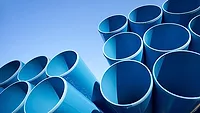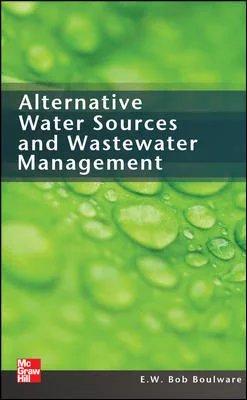Strategic Plumbing Insights | Christoph Lohr
Witnessing an Energy Water Nexus
LADWP La Kretz Innovation Center, ASPE LA Chapter and IAPMO’s Water Demand Calculator in California.

Image courtesy of the author.
On May 8, I had the distinct privilege of presenting at the Los Angeles Department of Water and Power (LADW) La Kretz Innovation Center for the American Society of Plumbing Engineers (ASPE) LA Chapter on California’s adoption of the Water Demand Calculator (Uniform Plumbing Code Appendix M). Reading my first sentence a second time and thinking about my experience, a distinct theme emerges instantly: the meeting of water and energy. Plumbing design professionals often joke with our peers in electrical design about how we don’t want to “mix water and electricity.” But this jest recently has been one that I am reconsidering — these two items are linked. Water and electricity — otherwise known as energy — are linked. Not only are they linked, but they are the foundation of our modern civilization. And the LADWP La Kretz Innovation Center is one of the best embodiments of the water energy nexus.
First some history: the Los Angeles Department of Water and Power (LADWP) La Kretz Innovation Campus opened in 2016. The goal was to establish a cleantech incubator dedicated to showcasing renewable products and processes toward a more sustainable future. In 2020, LADWP and IAPMO entered into a memorandum of understanding (MoU) with the mutual goal of promoting water conservation, respective efforts and support in the development of technological innovations and the green plumbing industry. As part of the MoU, LADWP will provide workspace in a laboratory for an IAPMO project engineer at the La Kretz Innovation Campus (LKIC).
Walking through La Kretz, I was struck by how much the innovation center embodies a living visual of the water energy nexus. There was, of course, the laboratory that IAPMO manages, but other exhibits showed water and energy savings from high-efficiency water closets, how lighting intensity and tones impact energy usage, and how water and energy are inescapably linked. It was in this setting that the ASPE LA Chapter decided to meet for the second year, but this time to learn about IAPMO’s Water Demand Calculator adoption in California, which goes into effect on July 1.
The ASPE LA Chapter was — as always — engaged and lively as well as being warm and welcoming toward me, personally. My presentation was organized into the benefits of adopting the Water Demand Calculator, its adoption in California, how to use it, and its future — specifically, the benefits of adopting the Water Demand Calculator, including reduction in construction costs and the potential to lower water age, but also reducing water and energy usage and reducing embodied carbon:
- In a 2020 study by Stantec, construction cost savings by using the WDC for a single-family home were estimated to be up to 7% in piping material costs. For multifamily construction, estimated cost savings were about $1,000 per unit in piping material costs (e.g. a 50-unit apartment would expect to see $50,000 in material cost savings). All values were based on pre-pandemic RS Means information.
- In a 2023 study by Arup, water savings for a single-family home prototype were estimated to be about 450 gallons per year.
- In a 2023 study by Arup, embodied carbon savings for a single-family unit were estimated to be 32.9 CO2e, while the embodied carbon savings for copper of a prototype 48-Unit high rise were estimated to be 20%.
Now there have been some questions if right-sizing can save water and energy, and whether there is any peer-reviewed literature or independent analysis done on this topic. The good news is that most certainly there is: the water and energy conservation advantages of smaller-diameter distribution networks have been demonstrated and described in many peer-reviewed publications published beginning in the 2000s, and perhaps before. The reported benefits and studies supporting them are as follows (the full list can be found at the bottom of the article):
- Smaller-diameter pipes produce water savings through reduced waiting times for hot water (less water is wasted to drain waiting for hot water arrival) (Ferreira and Goncalves, 2020; Lutz, 2011; Omaghomi and Buchberger, 2018)
- Smaller diameter pipes have lower distribution system energy losses (particularly losses associated with cool down of heated water between hot water draws) than larger diameter pipes and fittings (Chen et al., 2021; Healy et al., 2021; Hendron et al., 2009; Hiller, 2011, 2006, 2005a, 2005b; Josey et al., 2023; Josey and Gong, 2023; Lutz, 2011, 2005; Omaghomi and Buchberger, 2018; Parker et al., 2015). Studies universally identify hot water distribution energy losses as the primary source of wasted energy and as the best opportunity for mitigating energy losses.
- Smaller diameter service lines and meters produce more accurate metering, better cost recovery by utilities and enhanced ability to detect leaks for building owner/operators (Creaco et al., 2016; Douglas et al., 2019).
- Smaller diameter pipes result in more frequent and complete turn-over of water in distribution systems, with potential water quality benefits (Bédard et al., 2018; Clements et al., 2023; Josey and Gong, 2023; Lautenschlager et al., 2010; Nisar et al., 2020; Rhoads et al., 2022; Schück et al., 2023; Ye et al., 2022). This is particularly important for systems with low-flow fixtures, but mismatched distribution systems not sized for flows of the low-flow fixtures. This potential benefit remains a topic of study, since water quality studies of green buildings have generally shown worse chemical and biological water quality than in comparable conventional systems. Researchers have hypothesized that worse water quality in green buildings can be attributed to higher surface-area-to-volume ratio for smaller diameter pipes and to reduced water usage (less turnover). Alternatively, degraded water quality in green buildings could be the result of system designs and operation that are inconsistent with low-flow fixtures and modern water usage and might be mitigated via smaller diameter (right-sized) distribution systems and periodic purging. That said, there is an emerging thinking that the Water Demand Calculator may be able to help mitigate the risk of Legionnaire’s Disease by reducing the water age.
- Smaller-diameter networks have lower materials costs than larger diameter networks (Ferreira and Goncalves, 2020; Josey and Gong, 2023).
Hobbs et al. (2019) conducted the most compelling study demonstrating the advantages of using the Water Demand Calculator approach for water demand estimation and plumbing system design. In a head-to-head study comparing the Water Demand Calculator method to two other relatively recent approaches for estimating loads (the Modified Wistort Method [MWM], the Exhaustive Enumeration Method [EEM] and the Loading Unit Normalization Assessment [LUNA] method), the authors determined that “the Water Demand Calculator model is conceivably the most compatible with that of the plumbing industry's design requirements,” suggesting this model could easily be adapted to meet the requirements across international borders.
Plumbing design professionals often joke with our peers in electrical design about how we don’t want to “mix water and electricity.” But this jest recently has been one that I am reconsidering — these two items are linked. Water and electricity — otherwise known as energy — are linked.
While I was at La Kretz, I was fortunate to have LADWP’s James Kemper, program manager of Codes and Standards of Efficiency Solutions Engineering, make me aware of a new data source quantifying water and energy savings by the Water Demand Calculator: a 2025 CASE Report on Multifamily Domestic Hot Water and Energy code rulemaking where the TRC Companies and Frontier Energy looked at four different multi-family prototype buildings and estimated water savings between 257 gallons to 320 gallons per unit per year by right-sizing the hot water system via Appendix M. This is similar to the values identified in the Arup Sustainability Report. Using these numbers TRC and Frontier Energy further estimated that utilization of Appendix M in new multifamily construction projects could save California more than 9 million gallons of water in the first year, and more than 50,000 kWh in first-year embedded electricity savings.
Water and energy are linked. Seeing the La Kretz Innovation Campus reminded me of this. James Kemper (LADWP) reminded me of this. Finally, Amir Tabakh, manager of Efficiency Solutions Engineering & LADWP La Kretz Labs, also reminded me of this when he shared a copy of the LADWP 2022-2023 Briefing Book, which states “Water and power support the quality of life and vitality of ... our communities.”
I couldn’t agree more.
Looking for a reprint of this article?
From high-res PDFs to custom plaques, order your copy today!










